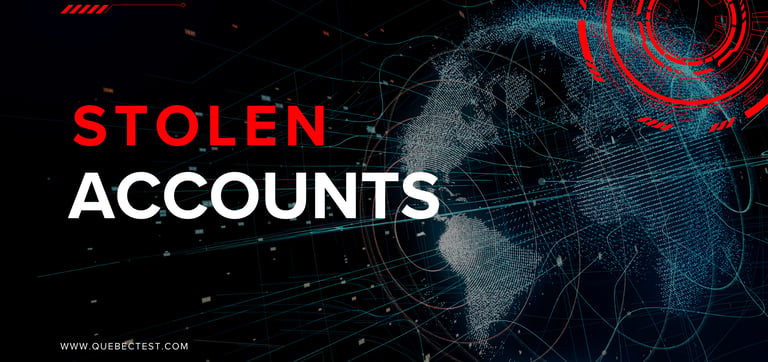Stolen Accounts: Black Market Just a Click Away
From bank accounts to social media logins — everything’s for sale online. Here’s how it works… and how to protect yourself.
EN - SECURITY & PRIVACYEN - TUTORIAL
Quebec Test
8/15/20252 min read


Buying a bank account, access to an electric vehicle charging service, or even a loyalty program profile… all in just a few clicks?
This isn’t a movie plot — it’s the reality revealed by an investigation from La Presse.
And as someone who often covers digital security, I can tell you: cybercriminals have made fraud as easy as shopping on Amazon.
A Supermarket for Stolen Accounts
Think of it as an “Amazon of crime”: websites and private Telegram groups offer over 70 categories of compromised accounts — banks, Loto-Québec, Hydro-Québec, delivery services, social media…
And here’s the kicker: they even sell guides on how to bypass two-factor authentication (2FA), the very tool meant to protect your accounts.
The prices? Ridiculously low:
20 bank accounts: $60
500 accounts: $1,200
Some even contain tens of thousands of dollars… and sell like hotcakes.
A Growing Problem in Quebec
The Canadian Anti-Fraud Centre reports that nearly 50% of identity theft cases in Canada during the first half of 2025 originated in Quebec.
And this black market isn’t limited to the dark web — some of it is out in the open, easy to find with a simple Google search.
Globally, the trend is alarming: a 2024 academic study found that more than 38,000 social media accounts were put up for sale between February and June, worth over $64 million in total.
How to Protect Yourself
The good news? You can dramatically reduce your risk with a few simple habits — if you stick to them consistently.
1. Prevent Before It Happens
Enable 2FA everywhere: it’s your second lock. Use an app like Google Authenticator or Authy instead of SMS, which is more vulnerable.
Strong, unique passwords: at least 12 characters, mixing letters, numbers, and symbols. No more “123456” or “password123”.
Use a password manager: Bitwarden, 1Password, LastPass… so you never reuse the same password.
Avoid public Wi-Fi without a VPN: without encryption, you’re like an open book.
Be wary of phishing: unexpected emails asking you to click? Always suspect them.
2. Spot a Breach Early
Check your bank statements weekly.
Review your account login history (Google, Facebook, etc.).
Turn on alerts for logins from new devices.
Test your email on haveibeenpwned.com to see if it has leaked.
3. Act Fast if You’re Compromised
Change your passwords immediately.
Contact your bank or the affected service to freeze the account.
Report the incident to the Canadian Anti-Fraud Centre or your local police department.
4. Recommended Tools
Password managers: Bitwarden (free), 1Password.
Authentication apps: Authy, Google Authenticator.
Leak check: HaveIBeenPwned.
Identity monitoring: Equifax, TransUnion.
What this investigation shows is that cybercriminals are organized, fast, and ready to exploit the smallest gaps in your online habits.
By applying these measures now, you can drastically lower your risks tomorrow.
🎯 Also watch: my YouTube videos on online scams and smartphone security. In 2025, protecting your accounts means protecting your life.
Sources

